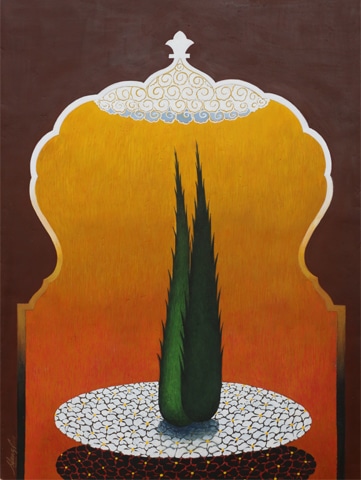Pakistan possesses a rich repository of heritage art, but works of traditional art, design and pattern (other than miniature painting) are commonly viewed as artisanal crafts only. Unlike fine arts, there are no research-based education programmes with innovation opportunities and gallery exhibition prospects reserved for traditional arts.
The recent VM Art Gallery show, Living Traditions, challenges these deficits with a diverse, thought-provoking collection of 130 traditional art-inspired works. The exhibition also marks the launch of the VM Centre for Traditional Arts and its new diploma programme in partnership with the Prince’s Foundation School of Traditional Arts (PSTA), London.
The PSTA is recognised for its academic and research excellence, high standards of practical skill and craftsmanship, and for its open and holistic philosophy. Its ideology centres on integrating the theoretical study of the traditional arts with their practical application in order to institute them as contemporary living arts that evolve and endure. Living Traditions showcases work with Pakistani heritage from the diploma programme’s expert team of tutors as well as work by 20 PSTA alumni, whose continual artistic practice reflects their unique education at the PSTA.
Contrary to postmodern art’s short-lived genres, traditional art offers an enduring permanence
In Pakistan, the miniature art revival and its ongoing contemporary evolution indicates just how successfully tradition can be reinvigorated. The Living Traditions show in Karachi is a first step in this direction and the wide range of art on view manifests the potential inherent in this endevour. Exhibits in VM Art Gallery A, primarily by fresh entrants, pertains to traditional ceramic kashi kari tile art, illumination, calligraphy and khatati motifs, studies of Islamic geometric patterns, marquetry experiments, basic wood and wire sculpted interweaves of circles, triangles, hexagons and polygons. These works illustrate the students’ understanding and mastery of elementary learner exercises. Evidence of creative impulse was minimal but their skill sets are well-developed. Among the few miniature-inspired artworks, floral replications by Alefiya Abbas Ali are praiseworthy.

For contemporary artists, willfully opting for classical techniques, tradition is a point of departure in their practice. In Gallery B and C, the innovative instinct was clearly assertive as established artists and PSTA alumni played with their skills and imagination. Nida Bangash’s intricate, deftly rendered ‘Tree of Life’ series was not just a visually delightful play with pattern, it also provoked questions on the concept of belongingness and impermanence, of home and homelessness, in a conflict-ridden world.
Aqeel Solangi, moved by the sacred beauty of nature, paints life through the lens of memory, experience and time. In this show, his paintings featuring a cypress tree and floral ciphers, explore transience. In the classical tradition, the cypress was associated with death and the underworld because it failed to revive when cut too severely — it also symbolises immortality, elevation, hope and mourning.

Innovating within the rigid, often repetitive parameters of pattern without disturbing the essential geometric order is among the several challenges artists face when they source traditional vocabulary. Apparently simple, the ‘Steppe Eagle Ascending’ painting by PSTA tutor Isra Butt makes creative use of the geometric circle without violating its harmony. Mixing and aligning different traditional patterns, as in the ‘Kaftan’ series by Mahrukh Bashir, or tweaking pattern elements to produce gestural sweeps, as in ‘Raqs-i-Rumi’ by Sadia Farooq, are other contemporary recasts of conventional formats.
Both replications of classic patterns as well as tradition-inspired contemporary expression in this exhibition are methodology-centred. Unlike the defiant nature of contemporary art, that questions and challenges existing norms in its search for the ever elusive new ‘ideal’ created with an unrestricted range of conventional and unorthodox media, traditional art focuses on continuity. Here, originality means ‘from the origin’, returning to first principles as well as cultural and artistic roots. For artists who reference tradition, originality means learning the ancient, arduous but revered practices and nurturing them as living forms in order to bring forth new creations.
The PSTA philosophy rekindles students’ awareness that form, pattern and colour in traditional arts are not simply aesthetically pleasing nor merely tools for design, but that embody a profound beauty: the beauty of the permanent that shines through in the world of the transient. In their intense research, learning and practice of the traditional arts, students can experience the beauty of the order of nature — a spiritual, sacred beauty that connects the whole of creation.

Having exhausted the modernist Duchampian model, postmodern art today is a scattered array of several, often short-lived, genres with no cohering anchor in sight. In contrast, traditional art offers an enduring permanence. Its steady, disciplined practice of crafts and skills are deeply-rooted in the inspirational principles common to all traditional cultures. The advantages of drawing from one’s roots yet remaining globally connected have already been exemplified in the evolution of the contemporary miniature.
“Living Traditions” was displayed at the VM Art Gallery in Karachi from September 1 to September 29, 2018
Published in Dawn, EOS, September 30th, 2018
















































Dear visitor, the comments section is undergoing an overhaul and will return soon.